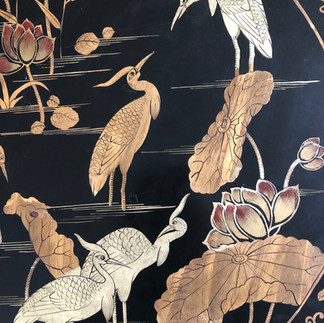Chinoiserie
- rosiblister
- Apr 12
- 3 min read
Chinoiserie, from 'chinois' the French for Chinese.
I purchased this beautiful little wine table from an auction last summer. It is in remarkably good condition considering its age. I have always loved chinoiserie as a decorative style and have enjoyed marvelling at the designedly exuberant concoctions of eastern-inspired fantasy, in many country houses I have visited. So, I was determined to dedicate at least one room to it, here at home.
Chinoiserie is not Chinese. Neither is it Japanese or Indian although many of its popular motif’s might trick you into thinking that it was. Chinoiserie is actually an English and French invention that took inspiration from the exotic and mysterious artefacts being imported to this country, as trade increased between east and west from as early as the 16th century. These items began to be collected by the very wealthy and by the 17th and 18th centuries, English designers and makers including the notable Thomas Chippendale, were incorporating eastern inspired elements into their own work, increasing the popularity and availability of oriental design. Chinoiserie was a style that was applied to all design fields including architecture and garden design, furniture, wallpaper and porcelain. It became the must-have addition to the country homes of the upper classes, and it can still be seen in all its exotic splendour in grand houses the length and breadth of the British Isles.
European Chinoiserie designs were developed using both Chinese and Japanese motifs, including fantastical landscape scenes, gilded dragons, birds of paradise, pelicans, fish and oriental figures wearing flowing silk kimonos. They also combined oriental designs with Indian ones, making Chinoiserie a truly fictional and unique style all of its own. I think the designers of the time must have had great fun, letting their imaginations run riot!
My little wine table is the starting point for the creation of our own take on Chinoiserie design for our dining room. It too requires a good deal of imagination, as this room is currently being used as a store and general dumping ground for tins of paint!
The room has three very tall windows; two looking over the formal garden which will become floor to ceiling glazed doors and one into the rear yard where I dry the washing. For the latter window we have managed to find a beautiful panel of Scottish stained glass, featuring stylised floral motifs in deep yellow and mauve-blues. This will hide the view of the washing! The other two windows will be framed by four, full height, exotically carved Indonesian pillars found at auction in the dim and distant past. The walls will be painted deep F&B India Yellow, the name attributed because of the pigment dye being historically created using the urine of sacred cattle. The ceiling will be clad with American tin tiles (purchased for a different property) that will reflect the candlelight from giant five-arm candelabras, when the table is set for dinner. I am now searching for a suitably ‘Japanned’ cabinet to store my good cutlery, which will complete the ensemble.
I do so love to take one item, or design element, and then wrap around it with a myriad of flamboyant gestures. This is one end of ‘extreme’ that we are playing with in this collector’s house of ours. At the other end of the scale, in other rooms, we are applying calm and harmonious schemes, but not in the dining room!

















Comments